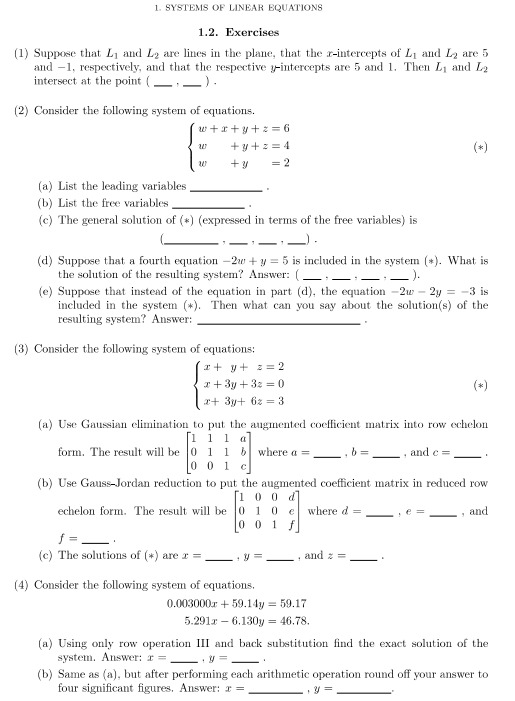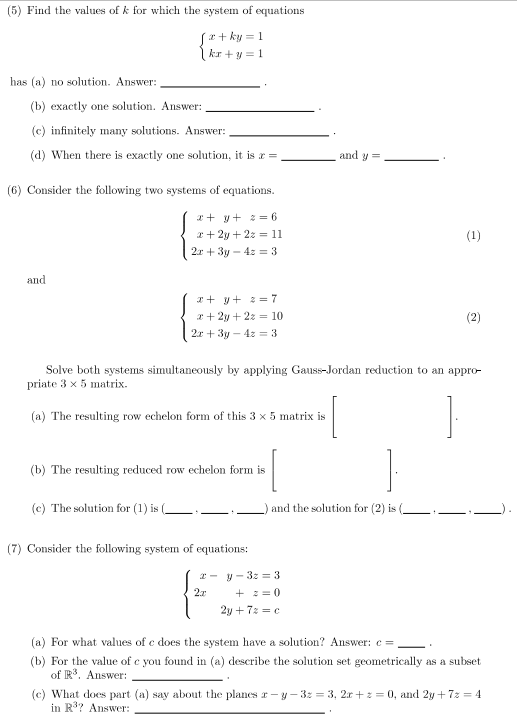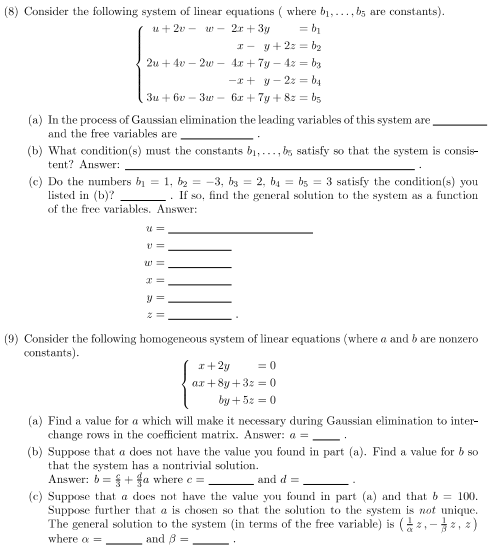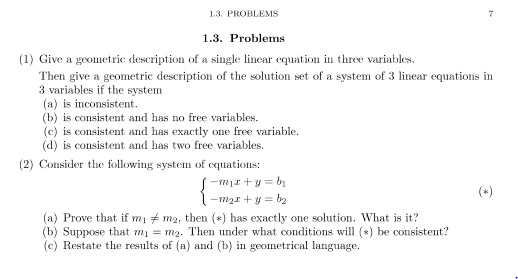INSTRUCTIONS:
1) Do all necessary steps
2) This is a whole paper. No data is missing.
1. SYSTEMS OF LINEAR EQUATIONS 1.2. Exercises (1) Suppose that In and Ly are lines in the plane, that the r-intercepts of Ly and Ly are 5 and -1, respectively, and that the respective y-intercepts are 5 and 1. Then , and Ly intersect at the point ( _ _ ) . (2) Consider the following system of equations. +#+2 =4 (# ) + y = 2 (a) List the leading variables (b) List the free variables (c) The general solution of (*) (expressed in terms of the free variables) is (d) Suppose that a fourth equation -2w + y = 5 is included in the system (*). What is the solution of the resulting system? Answer: ( _. (e) Suppose that instead of the equation in part (d), the equation -2w - 2y = -3 is included in the system (*). Then what can you say about the solution(s) of the resulting system? Answer: (3) Consider the following system of equations; I+ 7+ 2=2 + 37 + 3= = 0 (* ) at 3y+ 6z = 3 (a) Use Gaussian elimination to put the augmented coefficient matrix into row echelon 1 form. The result will be 1 b where a = - , and c = oolc (b) Use Gauss-Jordan reduction to put the augmented coefficient matrix in reduced row 1 ood echelon form. The result will be 0 1 0 e where d = and 0 0 1 f f= (c) The solutions of (*) are r = _ - , and : = (4) Consider the following system of equations, 0.003000x + 59.14y = 59.17 5.291x - 6.130y = 46.78. (a) Using only row operation III and back substitution find the exact solution of the system. Answer: I = (b) Same as (a), but after performing each arithmetic operation round off your answer to four significant figures, Answer: I =(5) Find the values of & for which the system of equations [at ky = 1 krty = 1 has (a) no solution. Answer: (b) exactly one solution. Answer: (c) infinitely many solutions. Answer: (d) When there is exactly one solution, it is r = and y = (6) Consider the following two systems of equations. at+ 2=6 c + 20 + 2= = 11 (1) 2x + 3y - 42 = 3 and at vt = =7 x + 2 + 2: = 10 (2) 2x + 3y - 4: = 3 Solve both systems simultaneously by applying Gauss-Jordan reduction to an appro- priate 3 x 5 matrix. (a) The resulting row echelon form of this 3 x 5 matrix is (b) The resulting reduced row echelon form is (c) The solution for (1) is (_ _) and the solution for (2) is (_ (7) Consider the following system of equations: @ - y - 32 = 3 2.T + :=0 2y + 72 = c (a) For what values of c does the system have a solution? Answer: c = (b) For the value of c you found in (a) describe the solution set geometrically as a subset of RS. Answer: (c) What does part (a) say about the planes r - y - 3: = 3, 2r + = = 0, and 2y + 7: = 4 in R$7 Answer:(8) Consider the following system of linear equations ( where by, .... b; are constants). at 20 - w - 2:+ 3y I - v +2= = by 2n + 40-20 - 4x + 7y -42 = b3 -it y- 2: = b4 3u + 60 - 3w - 6x + 7y + 8: = b; (a) In the process of Gaussian elimination the leading variables of this system are and the free variables are (b) What condition(s) must the constants b1, ...,by satisfy so that the system is consis- tent? Answer: (c) Do the numbers bj = 1, by = -3, by = 2, by = by = 3 satisfy the condition(s) you listed in (b)? . If so, find the general solution to the system as a function of the free variables. Answer: 71 = TE (9) Consider the following homogeneous system of linear equations (where a and b are nonzero constants). r + 20 =0 or + 87 + 3: = 0 by + 5= = 0 (a) Find a value for a which will make it necessary during Gaussian elimination to inter- change rows in the coefficient matrix. Answer: a = (b) Suppose that a does not have the value you found in part (a). Find a value for b so that the system has a nontrivial solution. Answer: b= ( + fa where c= and d = (c) Suppose that a does not have the value you found in part (a) and that b = 100. Suppose further that a is chosen so that the solution to the system is not unique. The general solution to the system (in terms of the free variable) is ( # # , - $2, 2) where o = _ and 8 =1.3, PROBLEMS 1.3. Problems (1) Give a geometric description of a single linear equation in three variables. Then give a geometric description of the solution set of a system of 3 linear equations in 3 variables if the system (a) is inconsistent. (b) is consistent and has no free variables. (c) is consistent and has exactly one free variable. (d) is consistent and has two free variables. (2) Consider the following system of equations: -mitty = bi (* ) (a) Prove that if my # me, then (*) has exactly one solution. What is it? (b) Suppose that my = ma. Then under what conditions will (*) be consistent? (c) Restate the results of (a) and (b) in geometrical language










